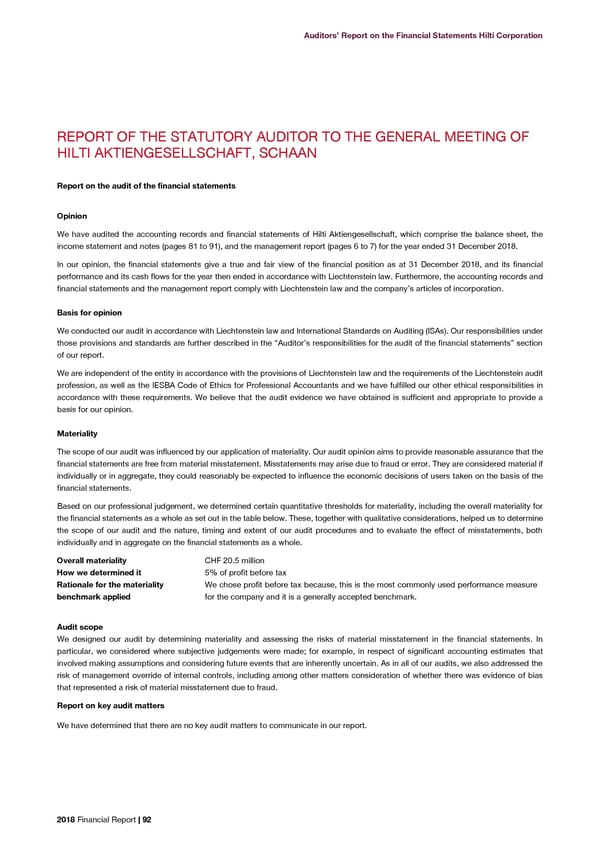Auditors’ Report on the Financial Statements Hilti Corporation REPORT OF THE STATUTORY AUDITOR TO THE GENERAL MEETING OF HILTI AKTIENGESELLSCHAFT, SCHAAN Report on the audit of the financial statements Opinion We have audited the accounting records and financial statements of Hilti Aktiengesellschaft, which comprise the balance sheet, the income statement and notes (pages 81 to 91), and the management report (pages 6 to 7) for the year ended 31 December 2018. In our opinion, the financial statements give a true and fair view of the financial position as at 31 December 2018, and its financial performance and its cash flows for the year then ended in accordance with Liechtenstein law. Furthermore, the accounting records and financial statements and the management report comply with Liechtenstein law and the company’s articles of incorporation. Basis for opinion We conducted our audit in accordance with Liechtenstein law and International Standards on Auditing (ISAs). Our responsibilities under those provisions and standards are further described in the “Auditor’s responsibilities for the audit of the financial statements” section of our report. We are independent of the entity in accordance with the provisions of Liechtenstein law and the requirements of the Liechtenstein audit profession, as well as the IESBA Code of Ethics for Professional Accountants and we have fulfilled our other ethical responsibilities in accordance with these requirements. We believe that the audit evidence we have obtained is sufficient and appropriate to provide a basis for our opinion. Materiality The scope of our audit was influenced by our application of materiality. Our audit opinion aims to provide reasonable assurance that the financial statements are free from material misstatement. Misstatements may arise due to fraud or error. They are considered material if individually or in aggregate, they could reasonably be expected to influence the economic decisions of users taken on the basis of the financial statements. Based on our professional judgement, we determined certain quantitative thresholds for materiality, including the overall materiality for the financial statements as a whole as set out in the table below. These, together with qualitative considerations, helped us to determine the scope of our audit and the nature, timing and extent of our audit procedures and to evaluate the effect of misstatements, both individually and in aggregate on the financial statements as a whole. Overall materiality CHF 20.5 million How we determined it 5% of profit before tax Rationale for the materiality We chose profit before tax because, this is the most commonly used performance measure benchmark applied for the company and it is a generally accepted benchmark. Audit scope We designed our audit by determining materiality and assessing the risks of material misstatement in the financial statements. In particular, we considered where subjective judgements were made; for example, in respect of significant accounting estimates that involved making assumptions and considering future events that are inherently uncertain. As in all of our audits, we also addressed the risk of management override of internal controls, including among other matters consideration of whether there was evidence of bias that represented a risk of material misstatement due to fraud. Report on key audit matters We have determined that there are no key audit matters to communicate in our report. 2018 Financial Report | 92
 2018 Financial Report Page 93 Page 95
2018 Financial Report Page 93 Page 95